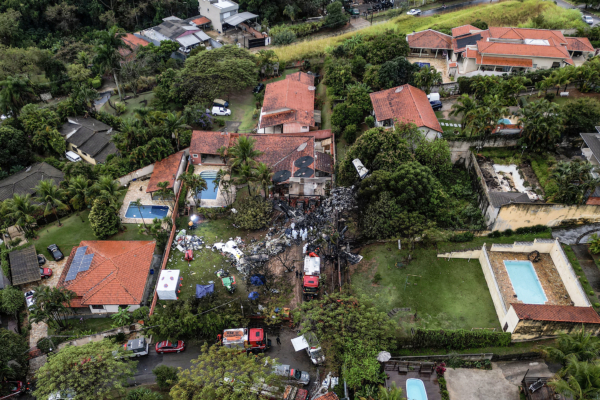On Friday, August 9, a plane belonging to the Brazilian airline VoePass crashed, resulting in the tragic death of all 61 people on board. Two passengers narrowly escaped the fate as they missed the flight by a stroke of luck.
These two passengers were originally scheduled to board the ATR 72 twin-engine turboprop plane that later crashed. They told Brazilian news media that it was precisely because they didn’t make it in time for this flight that they ultimately survived. One of them mentioned that at least 10 people missed this ill-fated flight.
One of the passengers, Adriano Assis, shared with GloboNews that he had just finished work at a hospital and arrived at the LATAM Airlines counter around 9:40 am to catch the 11:56 flight from Cascavel to Guarulhos.
Assis noticed that there were no LATAM staff at the service desk, so he grabbed a cup of coffee and checked the latest status of Flight 2283 on the screen.
He said, “There was no information about the flight on the screen, and no mention of it on the PA system.”
Only then did he realize that he had booked a flight with VoePass, not LATAM. When he switched counters, the line was long, and by the time he reached the agent, it was too late to board.
“The agent told me I couldn’t board because there was just an hour left until takeoff,” Assis said. He pleaded with the agent to let him board but was denied.
“I had a heated argument with him, and that’s how he saved my life, my friend,” he said tearfully. “He did his job because… if he hadn’t, maybe I wouldn’t be here giving this interview today.”
The VoePass Flight 2283 crashed in a residential area in Vinhedo, São Paulo state, with 57 passengers and 4 crew members on board.
At the time of the crash, Brazilian president Luiz Inácio Lula da Silva was participating in a naval event in the southern part of the country. He requested a minute of silence for the victims during the event.
“It seems they all perished,” he said in a shared video.
Footage showed the plane spiraling down vertically before hitting the ground amidst cries from witnesses. The crash site was engulfed in flames, with thick smoke billowing from the charred wreckage. Firefighters, military police, and civil defense teams were dispatched to the crash site.
Another passenger, Jose Felipe, recounted a similar mistake.
“I thought I was going to fly with LATAM airlines, but they had already closed,” he told GloboNews.
“Thank goodness we didn’t board that plane. We didn’t know it was the company’s (VoePass) plane; we thought it was the LATAM plane, but LATAM had shut down,” he said. “I arrived early at the airport, waited and waited, but nothing happened.”
When he finally found a staff member, he pressured them to let him board.
“Sir, I must get on the plane; I must go,” Felipe told the airline staff, but he was refused as he had missed the boarding deadline.
“He said there was no way, and all he could do was rebook my ticket,” Felipe said, noting that at least 10 people missed the ill-fated flight because they went to the wrong gate before takeoff.
The crash occurred in the Capela neighborhood, far from the city center with 77,000 residents. A witness told Reuters that the plane crashed onto the roof of an elderly couple’s home. Fortunately, there were no reports of casualties on the ground.
VoePass staff at Guarulhos airport informed the Associated Press that the company was in the process of notifying the families of the victims and providing support in a private room at the airport.
According to Fox News, aviation expert and former pilot Arthur Rosenberg stated that based on video footage, the aircraft appeared to stall in mid-air.
He explained, “A stall is when the plane’s forward airspeed isn’t fast enough to create sufficient lift to stay in the air. It sounds like one or both engines had an issue.”
Radar data indicated the airplane was in a “rapid descent,” which could be due to engine failure or other malfunctions.
Flight data from Flightradar24 showed that the Voepass aircraft lost communication one and a half minutes before the crash on its route from Cascavel to São Paulo. In the final minute before the crash, the plane descended around 17,000 feet.
The aircraft involved was an ATR 72-500 twin-engine turboprop plane primarily used for short-haul flights.
The manufacturer of the aircraft, the French-Italian company ATR, stated in a release that their experts were fully committed to assisting in the investigation and supporting the customers.
The black box of the aircraft, which contains the flight data recorder, has already been located by authorities.

